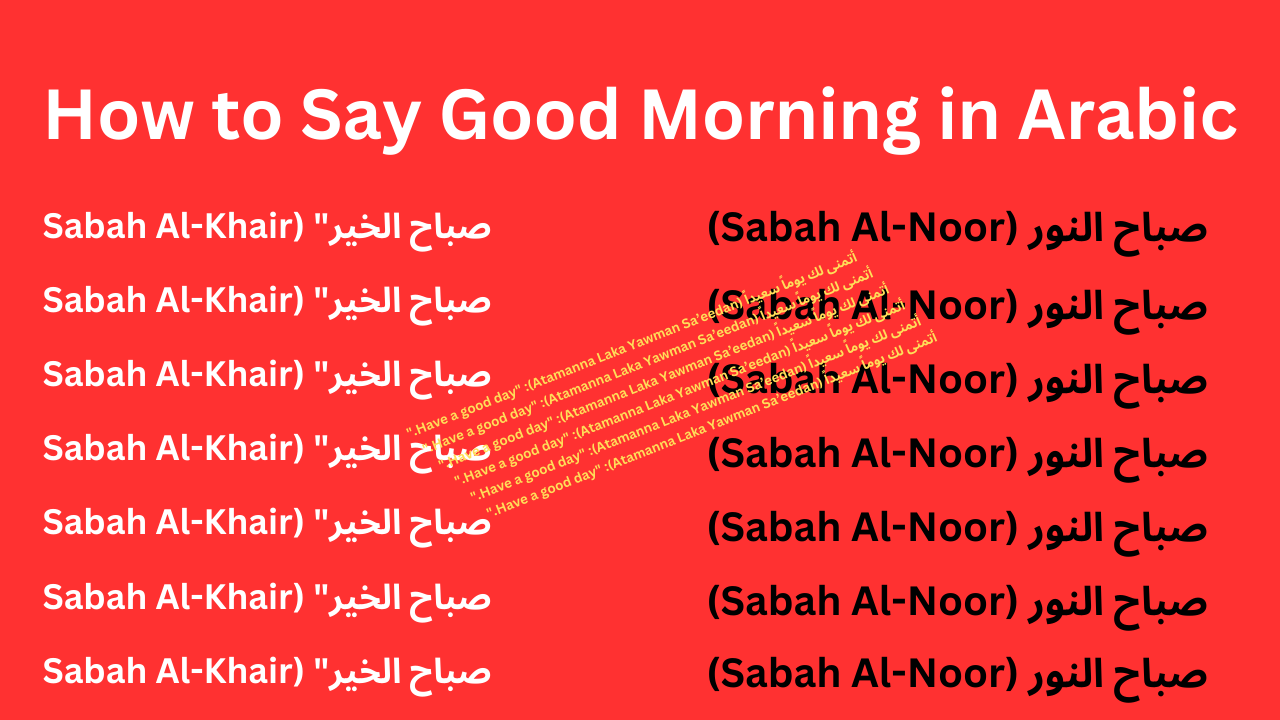Mastering greetings is one of the simplest yet most powerful steps when learning a new language. If you’re starting your Arabic journey, knowing how to say good morning in Arabic is a great first step. Greetings in Arabic are not just polite expressions; they carry cultural values of respect, warmth, and hospitality.
Whether you’re speaking to friends, greeting a shopkeeper, or starting a conversation at work, learning good morning in Arabic will help you build a friendly connection with native speakers. In this guide, we’ll cover the most common ways to say it, the proper responses, and easy tips to improve your pronunciation.
Common Ways to Say Good Morning in Arabic
The most widely used phrase for “Good Morning” in Arabic is “صباح الخير” (Sabah Al-Khair). This greeting is universal across Arabic-speaking countries and conveys a polite and positive tone, suitable for both formal and informal settings.
Key Phrases:
- صباح الخير (Sabah Al-Khair)
Translation: Good Morning
This is the standard way to say “Good Morning” in Arabic and is appropriate in almost any context.
- صباح النور (Sabah Al-Noor)
Translation: Morning of Light
This is a polite and poetic response to Sabah Al-Khair. It signifies goodwill and optimism.
For example:
- Colleague Greeting
A professional setting like an office:
-
-
- Speaker 1:** “صباح الخير (Sabah Al-Khair)”**
- Speaker 2:** “صباح النور (Sabah Al-Noor)”**
-
- Shopkeeper Interaction
A friendly encounter at a local shop:
-
-
- Customer:** “صباح الخير (Sabah Al-Khair)”**
- Shopkeeper:** “صباح النور (Sabah Al-Noor)”**
-
- Family Gathering
A casual greeting among family members:
-
-
- Parent:** “صباح الخير (Sabah Al-Khair)”**
- Child:** “صباح النور (Sabah Al-Noor)”**
-
BONUS:
During Ramadan, “صباح الخير (Sabah Al-Khair)” can also reflect communal joy and blessings, adding an even deeper layer of meaning to the greeting.
Pronunciation Guide
Mastering pronunciation is key to using Arabic greetings confidently. If you’re new to Arabic, don’t worry—we’ve broken down each phrase for easy understanding.
- صباح الخير (Sabah Al-Khair)
Pronounced as Sa-bah el-KHAIR (with emphasis on the “KH” sound, similar to a soft throat “h” in English).
- صباح النور (Sabah Al-Noor)
Pronounced as Sa-bah el-NOOR (with a smooth “noor” sound).
Tips for Pronunciation:
- Focus on the deep “KH” sound in “Khair,” as it’s an iconic sound in Arabic.
- Practice with a native speaker or through a language learning app to refine your accent.
- Listen carefully to how native speakers use intonation to express warmth or respect.
Cultural Context for Using Good Morning in Arabic
When to Use These Greetings
- Morning Hours: “صباح الخير (Sabah Al-Khair)” is specifically used in the morning (generally until noon).
- With Strangers: It’s polite and appropriate to use “Sabah Al-Khair” when greeting people you’re unfamiliar with, like shopkeepers or taxi drivers.
- With Elders: Use a respectful, slightly formal tone when addressing elders. You might even add their title (e.g., Uncle or Aunt).
- During Social Gatherings: It’s customary to greet everyone individually when you enter a room, ensuring each person feels acknowledged.
Regional Variations
Arabic is a rich and diverse language, and some regions have their slight nuances for “Good Morning”:
- Egyptian Arabic: “صباح الخير (Sabah El-Kheir)” is pronounced nearly the same, with a melodic tone.
- Levantine Arabic: Common in countries like Lebanon and Jordan, phrases are pronounced with soft inflections that sound welcoming.
- Gulf Arabic: Known for its distinctive “Kh” sound, which can feel more pronounced.
Additional Morning Greetings in Arabic
Expand your repertoire of Arabic morning greetings with these phrases:
- أتمنى لك يوماً سعيداً (Atamanna Laka Yawman Sa’eedan): “Have a good day.”
- نهارك سعيد (Naharak Saeed): A poetic way of saying, “May your day be happy.”
- أسعد الله صباحك (As’ad Allah Sabahak): A formal greeting meaning, “May God make your morning happy.”
Using these phrases in various contexts will not only impress native speakers but also deepen your understanding of the culture.
Tips for Mastering Arabic Greetings
If you’re new to Arabic, here are some useful tips for building confidence when practicing “Good Morning” phrases:
- Practice with Native Speakers
Join language exchange platforms like HelloTalk or Tandem to practice live conversations.
- Use Language Learning Apps
Apps like Duolingo, Memrise, or Pimsleur offer pronunciation practice and interactive quizzes.
- Watch Arabic TV or Movies
Observe how characters greet each other in different cultural and social settings.
- Consistency is Key
Use these greetings every morning—whether traveling, practicing at home, or starting your day virtually with coworkers.
- Record Yourself
Recording your pronunciation and comparing it to native speakers can help pinpoint areas for improvement.
Bringing It All Together
By learning to say “Good Morning” in Arabic, you’re opening doors to meaningful communication and cultural understanding. Phrases like “صباح الخير (Sabah Al-Khair)” and “صباح النور (Sabah Al-Noor)” are more than just casual pleasantries—they’re acts of connection and respect.
From the workplace to family settings, mastering these greetings will not only boost your Arabic vocabulary but also help you build genuine relationships within Arabic-speaking communities.
Are you ready to take the next step in your Arabic learning? Explore top-rated Arabic language apps and online courses for more resources to enhance your skills!
Conclusion
ChatGPT said:
So there you have it – the most common ways to say good morning in Arabic and respond with confidence. Mastering these greetings is more than just learning words; it’s about understanding the warmth and respect that Arabic culture values. By practicing good morning in Arabic and other simple phrases, you’ll be better equipped to connect with native speakers, build meaningful relationships, and open the door to exciting cultural experiences.
FAQs About Saying Good Morning in Arabic
What does “Sabah Al-Khair” mean?
“Sabah Al-Khair” translates to “Good Morning” in Arabic and is commonly used to greet someone in the morning.
How do you respond to “Sabah Al-Khair?”
The typical response to “Sabah Al-Khair” is “صباح النور (Sabah Al-Noor),” meaning “Morning of Light.”
Are there regional variations in saying “Good Morning” in Arabic?
Yes, pronunciation and intonation differ slightly across regions like Egypt, the Levant, and the Gulf.
Is it appropriate to use “Sabah Al-Khair” with strangers?
Yes, it’s both polite and respectful to greet strangers with “Sabah Al-Khair.”
How can I improve my pronunciation of Arabic greetings?
Use language apps, practice with native speakers, and listen to Arabic media for authentic pronunciation.
What are some other useful morning phrases in Arabic?
Phrases like “أتمنى لك يوماً سعيداً (Atamanna Laka Yawman Sa’eedan)” (“Have a good day”) are also common morning expressions.
Are there formal and informal ways to say “Good Morning” in Arabic?
“Sabah Al-Khair” is versatile enough for both formal and informal contexts, though tone plays a role.
Can “Sabah Al-Khair” be used any time of the day?
No, it’s typically used only in the morning, up until around noon.
What is the cultural significance of greetings in Arabic society?
Greetings play a crucial role in Arabic culture, reflecting respect, warmth, and a sense of community.







